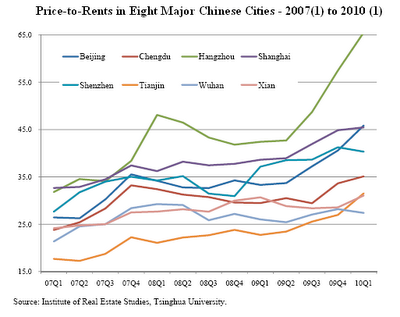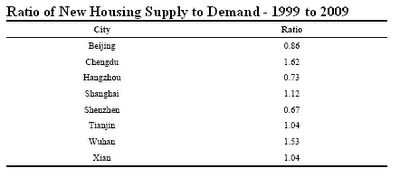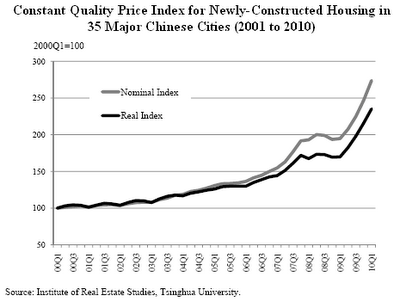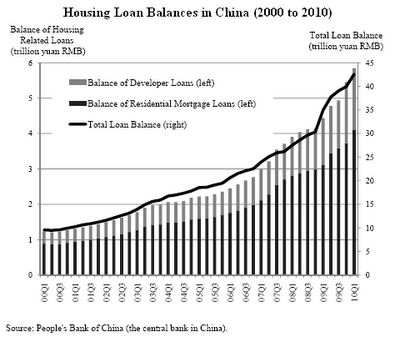There has been a lot of reports recently that China is in the midst of a colossal housing bubble.
In March this year Edward Chancellor, financial historian and bubble expert from Boston-based global investment management firm GMO, released an article entitled China’s Red Flags (available on the GMO website after registration). In this article, Mr Chancellor offers a checklist for identifying asset bubbles and then applies each factor against China. He warns that the Chinese economy is experiencing an unsustainable bubble whereby growth is being engineered by the Government, via excessive and wasteful fixed asset investment, in order to achieve high GDP numbers. Interest rates are also being kept artificially low in order to spur growth. But, as a consequence, a nasty bubble is developing in China’s real estate market.
Then in April this year, Jim Chanos, hedge fund manager at New York investment company Kynikos Associates, conducted an interview where he warned that China is experiencing a severe real estate bubble and is headed for a crash; rather than the sustained boom that most mainstream economists predict (video available here).
Now a recently released NBER research paper provides a detailed statistical examination of housing conditions in eight major Chinese cities with more than eight million residents – Beijing, Chengdu, Hangzhou, Shanghai, Shenzhen, Tianjin, Wuhan, and Xian. These cities accounted for over a third of all new housing sold by value in China in 2009.
This study suggests that bubble-like conditions are developing in each of these cities. As shown below, housing prices-to-rents have increased by at least 30% in each market over the past three years. The increase in price-to-rents has been particularly large in Beijing, where it has risen from 26 times in 2007 to 46 times in the first quarter of 2010. Hangzhou, Shanghai and Shenzhen have also seen their price-to-rents ratios rise sharply to over 40.
The increase in home prices has, however, been less than the rise in incomes in Chengdu, Tianjin, Wuhan and Xian. But prices in the coastal cities and in Beijing have outpaced even the high income growth experienced in those places. In fact, price-to-income ratios have reached their highest ever levels in Beijing, Hangzhou, Shanghai, and Shenzhen (see below chart).
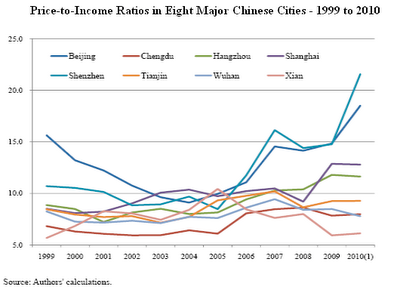
The authors also do not find evidence that the sharp rise in home prices is explained by population growth outstripping new construction (see below table). In fact since 1999, in five of the eight major cities – Chengdu, Shanghai, Tianjin, Wuhan and Xian – the number of new housing units was at least as large as the net increase in the number of households. Only in Beijing, Hangzhou and Shenzhen did the number of new households exceed the the net increase in the number of housing units. Even so, while upward pressure on prices is to be expected in these cities, the authors conclude that the demand-supply mismatch cannot account for the dramatic rise in home costs.
The authors conclude that home prices in many of China’s major cities are highly risky at these prices and that owners must be expecting very high rates of price appreciation for these price-to-rent ratios to be sustainable – classic bubble psychology. There is, therefore, a high risk that home prices could collapse if the rate of price appreciation slows or modest price falls are experienced. In the words of the authors:
“To provide some insight into just how risky prices and price-to-rent ratios are at these levels, we calculated what would happen if people began to expect that their homes would grow in value by only 4% per year. For Beijing, prices would fall by over 40%, absent offsetting rent increases or other countervailing factors.”
There is also the likelihood that other cities throughout China are experiencing bubble-like conditions in their housing markets, given the rapid pace of capital appreciation that has been experienced over the past decade in China’s 35 largest cities (see below chart).
Yet another credit explosion?
Like all property bubbles, China’s bubble appears to have been caused, in part, by rapid credit growth. Total loans outstanding increased by over 40% from the end of 2008 to the first quarter of 2010. Similarly, outstanding residential mortgages and loans to real estate developers have grown by 38% and 50% respectively over the same time period (see below chart).
Part of the reason behind this rush into housing is the Chinese Government’s near savings capture of its households and businesses. In order to spur economic growth, the Government sets the maximum interest rate paid by Chinese banks for deposits at 300 basis points below the minimum lending rate (and below the rate of inflation). The Government then funnels these massive deposits via state run banks into state-linked firms at below market rates, which then use these funds to build infrastructure and/or expand productive capacity.
Faced with earning an interest rate on deposits below the rate of inflation, Chinese savers have little option but to invest in real estate or domestic stocks, or to provide high interest rate black market loans through the shadow banking system, in order to earn a positive return.
Financial black hole:
According to a recent article by fellow blogger, Charles Smith, China’s residential property tends to be poorly built and prone to rapid deterioration and depreciation. The after market for apartments in China is also near zero, since few investors are interested in buying second-hand dwellings when there are thousands of brand-new ones available. As such, turnover in Chinese residential real estate is extremely low, in the order of 1% or less annually.
The risk is that many Chinese are pouring their life savings into an illiquid, deteriorating asset that, in all likelihood, cannot be sold without taking a significant haircut on their investment. According to Mr Smith:
“When the citizenry finally understand that the Central Government cannot stop prices from falling, or provide a deep, liquid market for re-sales, then panic will take hold, just as it does in the collapse of every bubble”.
But loan-to-value-ratios are low, right?
One factor that should work in favour of the Chinese housing market, when compared to its western counterparts, is that higher loan-to-value ratios (LVR) are required when taking out mortgages for property. In China, first time buyers are now required to provide a 30% deposit (recently increased from 20%), whereas investors are required to provide a 50% deposit (recently increased from 40%). Further, according to UBS, Chinese household debt as a share of disposable income is only 57%, whilst mortgage debt-to-disposable income is even lower at 33.5%. This compares to the United States where the equivalent ratios are 124% and 94% respectively, and Australia where the household debt-to-income ratio is over 150%.
So, on the face of it, these higher LVRs should reduce price volatility and cushion the Chinese banking system from mass defaults should the Chinese housing market correct.
However, as reported by Mike Shedlock from Sitka Pacific Capital Management, many of the down payments used to purchase properties are borrowed from the black market shadow banking system at high interest rates. As such, actual debt levels are higher than those reported by the official figures, making Chinese households more vulnerable to a correction than would appear by the official statistics:
“Families lend, friends lend, and they all rely on each other for cash reserves. The ties of honor and reputation are all that enforce repayment. It is a great shame if you can’t repay. Face is everything. Many simply repay by “rolling the debt” borrowing more to pay the vig.
Almost no one has the 20% to 30% down to buy a place. The down payment is typically borrowed at terrible interest or comes from a “marriage gift” which had its origin in borrowed funds, not from savings.
It’s like fractional reserve lending on steroids… A collapse of the bubble could cost lots of folks their life savings. This makes the financial aspect of Chinese society much more fragile than it appears on the surface. There is a lot of interconnected personal debt below the radar”.
A highly unstable economy:
If the housing market does correct, it could significantly slow the Chinese economy. According to the NBER research paper discussed at the start of this post, gross capital formation contributed over 90% of China’s GDP growth in 2009, offsetting the negative impacts of the decrease in exports following the onset of the Global Financial Crises (GFC). Private housing investment accounted for around 15% of total investment volume in urban areas in 2008 and about 13% in 2009. Further, output in the home construction industry constitutes around 6% of China’s GDP, employs around 14% of all workers in urban areas, and consumes around 40% of all steel and lumber produced in China. So it is safe to assume that any slowdown in housing production and/or the effect of a significant house price decline on the household sector would have an adverse impact on China’s economic growth.
More broadly, China’s economy is inherently unstable. China has a tiny consumer base – around the size of France’s – and its economy is heavily geared towards exports, not expanding consumption. Put another way, China cannot absorb (consume) its own goods, so it must export them in order to grow. But this strategy only works when there is a never-ending appetite for its products. And with its two main buyers – the European Union and the United States – both deleveraging and experiencing sluggish growth, their is little prospect that exports will return to their pre-GFC levels anytime soon.
So the Chinese Government is, instead, left subsidising production and consumption in order to maintain growth. But such an approach produces vast amounts of waste and is unsustainable. In the words of Jim Chanos, China is “on a treadmill to hell because 50% to 60% of GDP is construction… they’re really hooked on this sort of heroin of real estate development”.
Already, the leading indicators are not looking good for the Chinese economy. First, as reported in Bloomberg yesterday, China’s manufacturing data, as represented by the Purchasing Manager’s Index (PMI), was the weakest in more than a year.
Second, the Baltic Dry Index (BDI), which measures the demand to ship raw materials and is a leading indicator of commodities demand and raw materials production, recently experienced its longest fall in 15 years. This fall in the BDI reflected, in part, a reduction of Chinese steel demand and production and a corresponding slowdown in orders of iron ore.
Third, in June, real estate prices in 70 large Chinese cities declined over the previous month for the first time in almost one-and-a-half years – by 0.4% for new construction and 0.1% for existing structures. Given the extremely high price-to-rents ratios in China’s cities, and that high rates of capital appreciation are required to maintain these levels, China’s home prices are likely to continue correcting in coming months, placing China’s banks and households under pressure.
Finally, it has been reported that China’s banks are already facing losses on nearly one quarter of the 7.7 trillion yuan ($US1.1 trillion) of loans made to local government vehicles. According to this report, 27% of the loans to local government vehicles are being serviced by the cash flow generated by the underlying projects, whereas a further 50% of the loans are covered by a combination of cash flow from the projects and the underlying value of collateral or loan guarantees. But 23% of the loans, worth around 1.6 trillion yuan, are classified as doubtful. These loans are likely to have been made to allow local governments to embark on social projects, such as creating new parks or planting trees, or they could have been made to unqualified borrowers. Many of these loans are likely to have been squandered on bad investments, or on corrupt payments.
Trouble ahead for Australia?
A key reason why Australia was able to ride-out the GFC of 2008/09 was because of continued strong demand for commodities by China. China is Australia’s number one export destination, accounting for 22% of our exports. As such, Australia benefited directly from the massive building boom that emerged following the Chinese Government’s 4 trillion yuan ($US590 billion) stimulus package, which led to sharp rises in the prices of commodities, including iron ore, aluminium and copper.
However, if a significant slowdown emerges, evident by a fall in China’s infrastructure construction and/or apartment and home building, then demand for Australian commodities will fall sharply, leading to both lower commodity prices and decreased volumes being exported into China. The economic consequences for Australia from a sharp slowdown in China could, therefore, be enormous and would manifest itself through significantly lower economic growth, higher unemployment and falling asset prices.
What deeply concerns me is that while most of Australia’s mainstream commentators are alive to the opportunities that stem from Australia’s heavy exposure to China, they are completely unaware of the significant potential risks to China’s (and by extension Australia’s) economic outlook.
Till next time.
Cheers Leith

